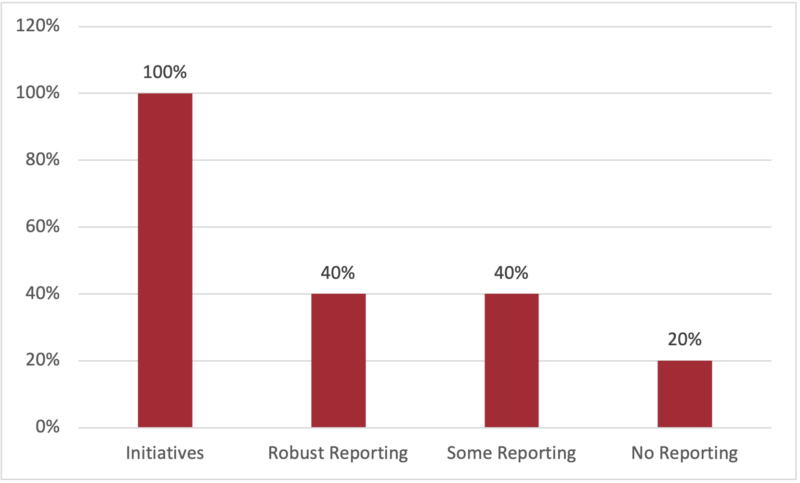As we compiled our Law Firm DEI Communications Report, we compared how many firms have DEI initiatives in place versus how many are reporting the actual results. We found that all firms have some kind of DEI initiatives, but only 40% of firms have robust reporting, another 40% have minimal reporting, and 20% have no reporting at all.

You may be asking why it’s so important for your firm to communicate the results of DEI initiatives. Isn’t it enough to indicate that you have initiatives and are working toward a more diverse workplace? Not exactly.
Even if your firm has comprehensive initiatives, if you’re not communicating the results, it’s a missed opportunity and may imply that your firm has something to hide. Continually reporting your progress shows that your firm is committed to DEI initiatives for the long-term and is making concerted efforts to improve. If you are investing time, effort, and resources into programming, you should be sharing the results.
While there are several ways to approach reporting, we suggest you start with these 4 questions.
1. How can I make my firm’s reporting more specific?: 60% of firms audited use general language in their reporting. They don’t separate distinct groups and instead group multiple “diverse” groups together.
- 30% of firms group all racial minorities together
- 15% of firms group race, ethnicity, and women together
- 15% of firms group race, ethnicity, and LGBTQ+ together
Only one firm separated racially diverse hires into separate groups, indicating percentages of Hispanic, African American, Asian, two or more races, and Caucasian.
These results raise the question of how firms are tracking DEI initiatives. If your firm is not already, we recommend starting to track the number of employees who belong to each demographic group, either through HR records or voluntary disclosure. Tracking and reporting this data shows that you value each individual group and can help to understand your employees. Most importantly, specific demographic reporting highlights where your firm is doing well and where you’re still lacking and can help you to set goals for the future. For example, you might have a high percentage of racial diversity for your associates but see those numbers decrease as you look at your partners and leadership. Tracking can help you plan how to improve these numbers over time.
2. What type of reporting should I use?: If you are reporting quantitative data (for example, the number of women in the incoming first year class), charts, graphs, and infographics are the best way to summarize your data. When you have information that is numbers-heavy and made up of hard facts, this type of reporting is a great way to show your results in a concise and impactful way, highlighting the most important information. For qualitative data, a report is a better way to go. Reports provide more space and freedom for storytelling and allow you to elaborate. You may wish to include employee testimonials, the background or history of your firm’s DEI efforts, goals for the future, or challenges that you’ve overcome.
3. How can I effectively communicate my firm’s results?: DEI reporting isn’t just about showing the numbers. It’s about communicating the results in a meaningful and impactful way. While the numbers are important, what’s even more important is how you use them. The magic happens when you put all the pieces of your firm’s DEI efforts together to tell one cohesive story. Effective storytelling will demonstrate how your DEI initiatives are positively impacting the firm.
A great first step is to determine what story you want to tell. Maybe your firm has made great strides in the past few years and you want to tell the story of this progress. Or maybe your firm has always been at the forefront of DEI and continues to be a trailblazer. Once you have your narrative in place, then communicate why it matters. This may include showing financial gains, higher employee retention, a larger client list, an elevated reputation, etc. Telling your story and backing it up with data is the most powerful way to show why DEI is a high priority for your firm.
4. How can my firm show its ongoing commitment to DEI?: Results should be tracked and reported consistently. Pick a timeframe that works for your firm, such as semi-annual, annual, or even bi-annual. Not only does this show that you understand that DEI is dynamic and should be constantly improving, but it’s also a great opportunity to publicize the firm and share updates with relevant parties.
Reporting the results of your firm’s DEI initiatives is an important part of communicating effort, commitment, and a willingness to be transparent. Taking these steps to track and report can go a long way to showing current and prospective employees and clients that they are valued and represented.
Three Furies is a certified woman-owned business, brand, and content strategy agency with deep experience in the legal marketing sector, including digital marketing analysis, brand and digital design, communications strategy, and advertising campaigns.